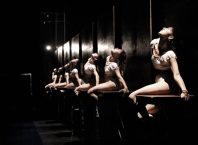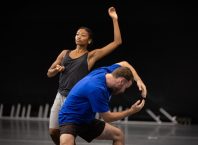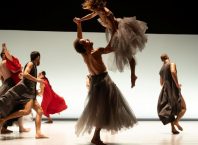A white square in the darkness, framed by white walls it becomes a three dimensional canvas, a museum gallery. This canvas is never empty, its blank walls are never mute, they sing centuries of history, a palimpsest of change and invention, this is the house that ideas built. One cannot look at these walls without a sense of expectation.
Wallflower by Inbal Pinto and Avshalom Pollak begins in medias res: as the audience enters the sculpture gallery of the Tel Aviv Museum of Art, three musicians are sitting on the white floor: Umitaro Abe, Mayu Gonto, and Hirofumi Nakamura. Dressed in black, illuminated by one light with the warm glow of a candle, their gaze turns inward. They play as if they are listening to something from within, music only they can hear, responding with the dance of their fingers on the strings of the violin and biwa, the round red mallet that strikes a green glass bottle.
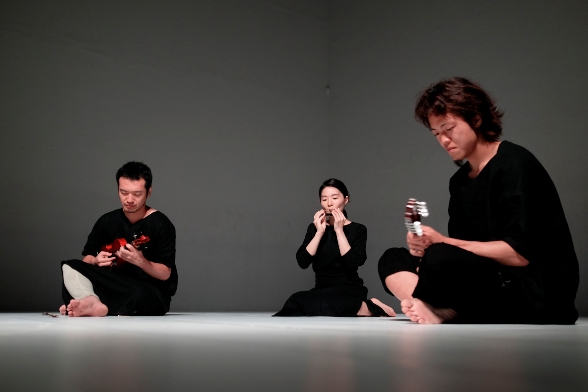
Dancers clad in knit bodysuits enter from two sides, walking simply up to the white square in the corner of the gallery, gathering in a slumbering heap of colors on the floor at the two opposing corners. A melody emerges, at once ancient and familiar, the sound of a circus or traveling show that calls one to follow. A tall man in black, Zvi Fishzon, walks up to the musicians and gently removes the bottle, wine glass and mallet, taking them away. He returns holding a music box no larger than the palm of his hand, turning the small handle. The musicians rise, Umitaro Abe and Hirofumi Nakamura walk away, holding their instruments, as Mayu Gontu takes the music box from Zvi with ceremonial gravity, then she too walks away. Zvi looks on as they depart with the solemnity of ritual and the sadness of parting.
One by one the dancers emerge from the heap in their vibrant second skins, the colors cover their body in curving lines, widening and narrowing, an abstract landscape. In this universe of pure color, swirls of belly, breasts and buttocks appear, sensual galaxies of human curves, nipples pointing to the place of desire. The skin of dreams.

Paint come to life, the dancers move, creating startling shapes and fascinating configurations. There is a dream path through this universe, floating on sound and image, one watches, mesmerized. Yet this is only one path of many. Bound between the white walls of the gallery are seemingly endless associations and ways of viewing. Wallflower emerges as one of Pinto and Pollak’s most powerful pieces, it feels like an artistic collaboration with the universe.
The dancers move along the walls, crawl hugging the floor, leap and curve, rise and fall, connect and separate. Something comes to life in this space, the secrets spill out and spin out their tales, showing everything and revealing nothing. The body is the site of imagination, that mysterious organic factory of cells, electricity, emotion and infinite secrets. This is heart of the matter, the raw material of Wallflower. It is always surprising, never safe. As one looks at the faces of the dancers, each one reflects an individual, the unknown past making an imprint on the present moment, the present movement. As one looks at the dancers, each one is an abstraction of lines, color and motion. What were we before we became ourselves? Who are we now?
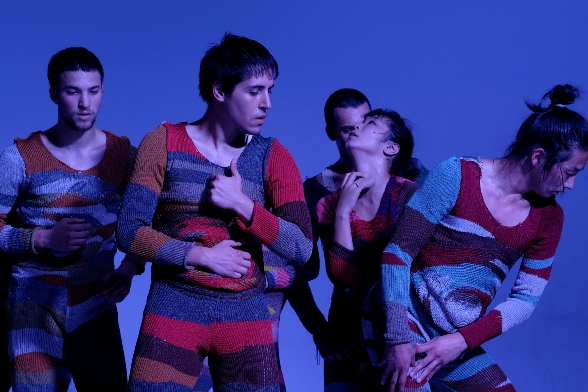
In Wallflower, Pinto and Pollak reveal a range of movement language as yet undiscovered in their previous work. Each of their creations is a world of its own, with its intricate language and vivid imagery, yet certain themes unite these worlds, and, until now, one might discern a particular Pinto/Pollak way of moving. Entering the space of the museum and creating within the walls of the sculpture gallery, they have let themselves be transformed by this experience, even as they transform and fill the gallery with their creation. The artistic collaborations within Wallflower generate layers of sensation and meaning. The very costumes become characters within the drama of the mover and the moved, art and artist, idea and object, vessel and spark of life, body and spirit. Music, costumes and lighting merge with the dance as one organic creation whose elements are inseparable, and whose cumulative effect is magnificent.
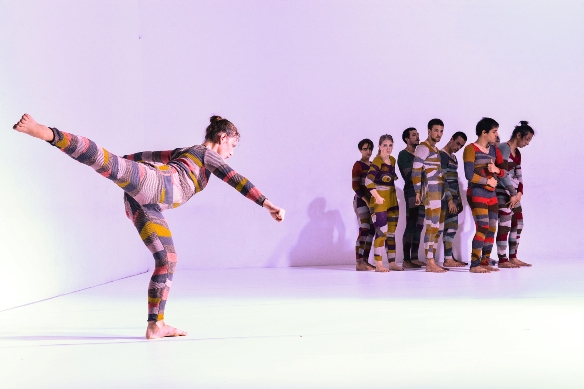
Scenes shift with dramatic speed: molecules in random walk, each dancer travels through this space in his or her own path and way, converging in trios and splitting off again. Clusters of color moving in and out like air through the lungs, coming together as a group in the center of the space, their breath audible, moving as they breathe, each different. So many permutations of form! Funny, audacious, and strange, these vessels filling with air then releasing it back into space, transformed. The dancers freeze, and the sound of the breath continues, taken up by the musicians until it becomes a note, sung, sustained. Inside the circle a dancer stands, Noga Harmelin, her eyes defiant, a finger pointing in the air. Suddenly, her whole body circles down to slap her thighs. Rising immediately with force, the action is repeated again and again, until she emerges from the circle fists clenched, in a fury of sharp movement, a rage of color. Power radiates from the core of her being, as if it might touch the far corners of the room, and all the dark space beyond. They all move then, as a group, the sound of blows merging with the sound of the accordion. Mirai Moriyama screams, and when this scream is echoed by Zvi, it almost feels as if one is screaming silently, inside, with them.
There is a freedom in every parting, and a loss. The emptying of the vessels is replete with possibility. Wallflower comes to the inevitability of its end, rising as it falls. The poetic sadness of the final moments, the omnipresence of death in life, gives way to a joy, a colorful buoyancy, an almost literal flight of the spirit. Touching the edges of imagination and existence, Wallflower leaves me with a question and challenge: what would it mean to become real to ourselves, how alive can we be?
Wallflower
Choreographers, Costumes and set design: Inbal Pinto, Avshalom Pollak; Lighting designer: Yoann Tivoli; Composing and musical performance: Umitaro Abe, Mayu Gonto, Hirofumi Nakamura; Textile and co-costumes designer: Moriel Dezaldeti; Co-costumes designer: Rinat Aharonson; Sewing: Ela Givol, Rosalind Noctor; Rehearsal Manager: Dina Ziv; Performers: Avidan Ben Giat, Zvi Fishzon, Noga Harmelin, Cordelia Lange, Mayumu Minakawa, Mirai Moriyama, Andrea Martini, Stav Struz, Tom Weksler, Gil Shachar; Production coordinator: Keren Yuval; Master carpenter: Gilad Bonneau; Lighting: Oren Elimelech; Sound: Asaf Ashkenazy; Wardrobe: Ela Givol

